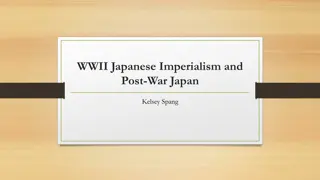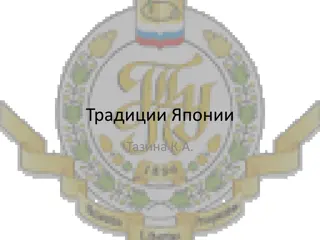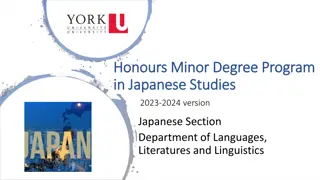Japanese Encephalitis: Overview and Management
Japanese encephalitis (JE) is a viral infection of the brain spread by mosquitoes, with symptoms ranging from mild fever to severe complications like encephalitis. Prevention is key through vaccination and avoiding mosquito bites. Diagnosis involves blood or CSF testing. Lifelong neurological issues can result from JE, making supportive care essential. The etiology involves Flaviviridae viruses, and diagnosis is done through IgM detection. Lifelong immunity is conferred with vaccination against Japanese encephalitis.
Download Presentation

Please find below an Image/Link to download the presentation.
The content on the website is provided AS IS for your information and personal use only. It may not be sold, licensed, or shared on other websites without obtaining consent from the author.If you encounter any issues during the download, it is possible that the publisher has removed the file from their server.
You are allowed to download the files provided on this website for personal or commercial use, subject to the condition that they are used lawfully. All files are the property of their respective owners.
The content on the website is provided AS IS for your information and personal use only. It may not be sold, licensed, or shared on other websites without obtaining consent from the author.
E N D
Presentation Transcript
Japanese encephalitis Japanese encephalitis (JE JE) Vandana Gupta Medical microbiology, Sem VI
Japanese encephalitis Japanese encephalitis (JE JE) An infection of the brain caused by the Japanese encephalitis virus (JEV). Mostly little or no symptoms, occasional inflammation of the brain occurs Spread by Culex mosquitoes with Pigs and wild birds as reservoir Diagnosis is based on blood or CSF testing. Prevention is generally with the Japanese encephalitis vaccine, which is both safe and effective. Other measures include avoiding mosquito bites. Once infected, there is no specific treatment, with care being supportive. This is generally carried out in hospital. Permanent problems occur in up to half of people who recover from JE. The disease occurs in Southeast Asia and the Western Pacific. About 3 billion people live in areas where the disease occurs. About 68,000 symptomatic cases occur a year, with about 17,000 deaths. Often, cases occur in outbreaks. The disease was first described in 1871.
Signs and symptoms Signs and symptoms IP of 2 to 26 days. Majority of infections are Asymptomatic: only 1 in 250 (0.4%) infections develop into encephalitis Fever, headache and malaise are other non-specific symptoms last for a period of between 1 and 6 days. Acute encephalitic stage include neck rigidity, hemiparesis, convulsions and fever: 38 41 C (100.4 105.8 F). mental retardation is usually developed. Mortality generally higher in children. Transplacental spread has been noted. Lifelong neurological defects such as deafness, emotional lability and hemiparesis may occur in those who have had central nervous system involvement.
Etiology Flaviviridae +ve sense RNA, nonsegmented genome Enveloped, icosahedral virus closely related to the West Nile virus and the St. Louis encephalitis virus.
Diagnosis Diagnosis Test kits detecting IgM Ab in serum and /or cerebrospinal fluid, for example by IgM capture ELISA. JE virus IgM antibodies are usually detectable 3 to 8 days after onset of illness and persist for 30 to 90 days, In fatal cases, nucleic acid amplification, and virus culture of autopsy tissues can be useful. Viral antigen can be shown in tissues by IFM.
https://upload.wikimedia.org/wikipedia/commons/thumb/f/f2/Japanese_encephalitis_vaccine_%22ENCEVAC%222016.jpg/220px-Japanese_encephalitis_vaccine_%22ENCEVAC%222016.jpghttps://upload.wikimedia.org/wikipedia/commons/thumb/f/f2/Japanese_encephalitis_vaccine_%22ENCEVAC%222016.jpg/220px-Japanese_encephalitis_vaccine_%22ENCEVAC%222016.jpg Prevention Infection with Japanese encephalitis confers lifelong immunity. There are currently three vaccines available: SA14-14-2, IXIARO/ JESPECT (JEEV) ChimeriVax-JE (marketed as IMOJEV). All current vaccines are based on the genotype III virus. boosters recommended every three years for people who remain at risk Mosquito population control
Treatment no specific treatment supportive therapy for feeding, breathing or seizure control as required. Raised intracranial pressure may be managed with mannitol There is no transmission from person to person and therefore patients do not need to be isolated.
Epidemiology leading cause of viral encephalitis in ASIA, with up to 70,000 cases reported annually, Case-fatality rates range from 0.3% to 60% and depend on the population and age. Rare outbreaks in U.S. territories in the Western Pacific have also occurred. does not usually occur in urban areas. There had been 116 deaths reported in Odisha's backward Malkangiri district of India in 2016 Endemic in Gorakhpur in UP Evolution The virus appears to have originated from its ancestral virus in the mid- 1500s in the Indonesia-Malaysia region and evolved there into five different genotypes and spread across Asia.
























